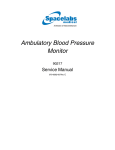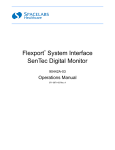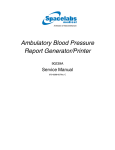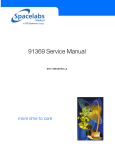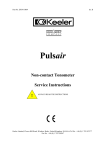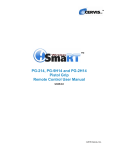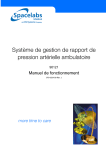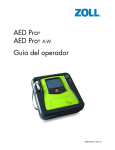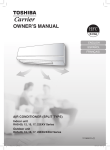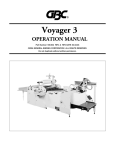Download 070-0137-03 90207-90217 Ops Manual
Transcript
Ambulatory Blood Pressure Monitors 90207/90217 Operations Manual 070-0137-03 Rev. L 070-0137-03 Rev.L i ii 90207/90217 Operations Manual ©2008 Spacelabs Healthcare Inc. All rights reserved. Contents of this publication may not be reproduced in any form without the written permission of Spacelabs Healthcare. Products of Spacelabs Healthcare are covered by U.S. and foreign patents and/or pending patents. Printed in U.S.A. Specifications and price change privileges are reserved. Spacelabs Healthcare considers itself responsible for the effects on safety, reliability and performance of the equipment only if: • assembly operations, re-adjustments, modifications or repairs are carried out by persons authorized by Spacelabs Healthcare, and • the electrical installation of the relevant room complies with the requirements of the standard in force, and • the equipment is used in accordance with the operations manual. Spacelabs Healthcare will make available, on request, such circuit diagrams, component part lists, descriptions, calibration instructions or other information which will assist appropriately qualified technical personnel to repair those parts of the equipment which are classified by Spacelabs Healthcare as field repairable. Spacelabs Healthcare is committed to providing comprehensive customer support beginning with your initial inquiry through purchase, training, and service for the life of your Spacelabs Healthcare equipment. CORPORATE OFFICES Spacelabs Healthcare Inc. 5150 200th Ave. SE Issaquah, WA 98029 USA Tel: +1 425 657 7200 Fax: +1 425 657 7212 Spacelabs Healthcare Ltd. 1 Harforde Court John Tate Road Hartford. SG13 7NW UK Tel: +44 (0) 1992 507700 Fax: +44 (0) 1992 501213 BirthNet, Clinical Browser, Data Shuttle, Flexport, Intesys, Mermaid, MOM, Multiview, PCIS, PCMS, PrintMaster, Quicknet, Sensorwatch, TRU-CAP, TRU-CUFF, TruLink, Ultralite, Ultraview, Ultraview Care Network, Ultraview Clinical Messenger, Ultraview Digital Telemetry, Ultraview SL, Uni-Pouch, UCW, Varitrend and WinDNA are trademarks of Spacelabs Healthcare, Inc. Brands and product names are trademarks of their respective owners. Caution: US Federal law restricts the devices documented herein to sale by, or on the order of, a physician Before use, carefully read the instructions, including all warnings and cautions. CE marked in accordance with the Medical Device Directive, 93/42/EEC 070-0137-03 Rev.L iii iv 90207/90217 Operations Manual Table of Contents Contents Page Table of Contents Operation Overview 1-1 ABP Monitor 1-1 Replacing the Batteries 1-2 Main Battery Replacement Lithium Battery Replacement (90207 only) Initializing the Monitor 1-2 1-2 1-3 Connecting Directly to a Local Report Generator Connecting Directly to the PC Interface Connecting to the Base Station via Modem Modem Speed and Compatibility Issues Office Check Mode Preparing the Patient and Precautions for Use Correlating with Manual Readings Patient Instructions 1-3 1-3 1-4 1-4 1-6 1-7 1-9 1-10 Data Transfer and Reports 1-10 Cleaning/Disinfecting Cleaning the Cuff and Carrying Pouch Removing/Installing the Bladder Event Codes 1-10 1-11 1-11 1-12 Accuracy Checking Accuracy 2-1 Accuracy Procedure 2-2 Troubleshooting Problem Solving Checklist 3-3 Servicing 3-3 Appendix A — Symbols 070-0137-03 Rev.L v 1-6 90207/90217 Operations Manual Operation Overview The Spacelabs Healthcare Models 90207 and 90217 Ambulatory Blood Pressure (ABP) monitors are small, lightweight, battery-powered monitors designed to take blood pressure and heart rate measurements for 24 or 48 hours, or for longer periods of time. These measurements are recorded within the monitors and may be transferred to an ABP Analysis System (FT1000A/FT2000A or equivalent), the personal computer (PC) interface, the base station, or in a Remote Connection mode (using modems). ABP Monitor The monitors have the following features: • Four-digit liquid crystal display (LCD) • Battery powered • Serial communications port • Power ON/OFF switch • Reading START/STOP button • Blood pressure cuff The monitors are carried in pouches that are strapped and/or belted to the side of the patient. Blood pressure and heart rate measurements are taken using a blood pressure cuff attached to the patients arm. This information is recorded in the monitors and can be transferred over a modem link or by direct connection between the monitors and one of the ABP analysis systems. The monitors can be programmed to either activate or deactivate the following features: • Display the cuff pressure at each bleed step • Display the systole, diastole, and heart rate at the end of each measurement. • Bleed to 40mmHg rather than stopping at the diastolic value. • Beep before and after each reading. Front Panel The 90207 and 90217 monitor front panels include the LCD display, cuff hose connector, and a START/ STOP switch. Rear Panel The rear panels of both monitors contain program input and output communication ports. On the 90207, the power ON/OFF switch is located on the rear panel. On the 90217, the ON/OFF switch is located on the top panel. 070-0137-03 Rev.L 1-1 Operation Replacing the Batteries “AA” batteries provide the main power source for both monitors. The 90202 monitor uses four batteries and the 90217 uses three batteries. These batteries should be replaced or recharged before the start of each patient monitoring session. Use either alkaline or Nicad batteries. The 90207 monitor uses a lithium battery (P/N 146-0008-xx) to back up the monitor memory and should be replaced periodically. The 90217 monitor backup battery should not require replacement. Main Battery Replacement Note: If the main “AA” batteries must be replaced during patient monitoring, this replacement must be accomplished within one minute to ensure successful resumption of the test (90207 only). 1. Power the monitor OFF, and remove the door over the battery compartment. 2. Replace the “AA” alkaline or Nicad batteries, being careful to observe polarities. Caution • The monitor will not operate if the alkaline, nickel cadmium, or lithium batteries are incorrectly installed. If the monitor is going to be stored for an extended period of time, remove the batteries to prevent the possibility of leakage or discharge. • Spacelabs Healthcare is not responsible for product damage incurred as a result of “AA” battery leakage. In the event your monitor has been damaged by a leaking battery, contact the battery manufacturer for any recoverable repair or replacement costs. Spacelabs Healthcare will assist you in determining those costs. 3. Gently replace the battery cover and secure the latch. 4. Power the monitor ON. Check that the LCD display is ON. If there is no display, power the monitor OFF and review the problem-solving checklist in Troubleshooting on page 3-1. Lithium Battery Replacement (90207 only) The lithium battery is located in the battery compartment under a pry-off cover to the right of the “AA” batteries. 1. Power the monitor OFF, and remover the door over the battery compartment. 2. Remove the pry-off cover, and note the polarity of the battery and socket indicators. 3. Remove the old lithium battery by carefully prying it out. Curved forceps are recommended. 4. Install the new lithium battery and replace the pry-off cover. The underside of this cover is divided into two unequal-sized compartments. Install the cover with the smaller compartment oriented over the lithium battery. 5. Gently replace the battery compartment cover and secure the latch. Note: Please ensure that discharged batteries are disposed of in accordance with local regulations. 1-2 90207/90217 Operations Manual Operation Initializing the Monitor The ABP monitors must be initialized prior to the start of patient monitoring. Initialization specifies the monitoring period, patient information, time format, measurement interval, monitor tone ON/OFF during selected periods, event code display, and whether or not to display pressure values. To initialize the monitor, connect it to one of the following analysis systems. Connecting Directly to a Local Report Generator For a direct connection to the 90207 or to the 90217 monitor, place the monitor into the chute on the Report Generator (Model 90239A or equivalent), as displayed in Report Generator . Figure 1-1: Report Generator Connecting Directly to the PC Interface For a direct connection to a PC-compatible computer via a Model 90121 or 92506: 1 Connect one end of the ABP interface cable to the serial port on the computer where the 90121 or 92506 software is installed. 2 Connect the other end of the interface cable to the ABP monitor. Refer to the 90121 ABP Report Management System Operations Manual (P/N 070-0529-xx) or the 92506 ABP Report Management System Client Application Operations Manual (P/N 070-0932-xx) for more information on the report management system. Figure 1-2: PC interface direct connect configuration 070-0137-03 Rev.L 1-3 Operation Connecting to the Base Station via Modem For a modem connection to a remote IBM XT/AT/PS2 (or equivalent) base station, refer to Figure 1-3 below. Figure 1-3: Modem connection configuration Note: The actual initialization procedure is discussed in the 90121 ABP Report Management System Operations Manual (P/N 070-0529-xx) and in the 92506 ABP Report Management System Client Application Operations Manual (P/N 070-0932-xx). Modem Speed and Compatibility Issues The 90207 and 90217 monitors operate Hayes-compatible modems only. You can identify your model type by plugging the communications cable into your 90207/90217 monitor and looking at the numbers on the display. The acceptable modem types and maximum speeds of 90207/90217 monitors are summarized below: Table 1: 90207/90217 Acceptable Modem Speeds Model Type Max Speed Modems Accepted Display older 90207 1200 1200 only 9999 90207-Q 1200 any Hayes 1999/9999 up to 9600 up to 9600 2999/9999 9600 any Hayes 0999/9999 older 90217 90217-Q Connection Procedure 1. Set the switches on the modem if you are using an older 90207 monitor with a 1200 modem, as follows: 1-4 Switch Number Setting at Monitor Site 1 down 2 up 3 down 4 down 5 down 6 up 7 up 8 down 9 up 10 up 90207/90217 Operations Manual Operation 2. Connect the serial port cable (P/N 012-0096-00) between the monitor and the modem. Note: If call waiting or call forwarding are options on a telephone used to transfer data, ensure that both are deactivated. Otherwise modem communications may be interrupted. In addition, telephone systems such as CBX or PBX can cause interference with the modem, or the modem can cause interference with the switching system. To initialize the monitor for remote connection: 1. Contact the base station by telephone (for remote operation only). 2. Ask the base station operator to initialize the monitor. Give the following information to the operator: • Patient’s name • Patient ID number • Whether monitor display is to be active or not • Time of day (12- or 24-hour format) • Whether to display measurement (systolic/diastolic and heart rate) • Multiple or single cycle times. If using a single cycle for the 24-hour monitoring period, indicate the cycle interval and whether the tone is ON or OFF. For multiple cycle times, specify each cycle interval and whether the tone is ON or OFF for each cycle. • Any other information the base station operator may request The base station operator will enter the patient information in the computer. 3. Prepare the monitor to receive the patient data from the base station. • Power ON the modem. • When instructed by the base station operator, power ON the ABP monitor. Note: The modem link must be established within 10 to 20 seconds for the 90207, and within 45 seconds for the 90217. If this does not occur, power the monitor OFF and then ON again to retry establishing the link. When the transfer of information is complete, the ABP monitor will beep. Voice communication is restored after the monitor beeps. • Power OFF the monitor and disconnect the monitor from the modem. • If a direct connection between the monitor and the base station is used, power OFF the monitor and then disconnect it from the ABP data interface unit. Modem Indicator Lights Modem indicators at the local modem are lit, flashing, or unlit depending on the stage of operation. When the monitor is powered ON, the RD (Receive Data) and SD (Send Data) lights will flash for several seconds. The OH (On Hook) indicator becomes lit when the monitor starts communicating with the remote modem. When the modems connect, the CD (Carrier Detect) is lit. The SD and RD lights flash as data is being transferred. After the transmission is complete and the monitor is powered OFF, the HS, TR, and MR indicators will always remain lit at the local modem 070-0137-03 Rev.L 1-5 Operation Setup Test Note: Verify that the cable connections are secure. Power ON the ABP monitor. It will display “9999.” While the monitor is being read or initialized, the digits will change to indicate that communication is taking place between the monitor and the analysis system. When communication is complete, the digits will no longer change. Office Check Mode The monitor automatically enters an Office Check mode for the first five measurements immediately following initialization. This allows you to verify the performance of the monitor on an individual patient without the need for re-initialization to reset the display features. While in the Office Check mode, the monitor operates as follows: • Displays the cuff pressure on each bleed step. • Displays systole, diastole, and heart rate at the end of the measurement. • Bleeds one step below the diastolic value as determined by the monitor. Terminating Office Check Mode For the 90207 monitor (versions earlier than 2.14), press the START/STOP key twice to cancel each of the remaining readings. The Office Check mode is terminated when the sum of the cancelled and successful measurements equals five. For the 90217 and the 90207 monitors (versions 2.14 and later), press the START/STOP key twice to cancel a single blood pressure reading. The Office Check mode is terminated when a blood pressure reading is cancelled. Any event that prevents a successful blood pressure measurement (other than a manual cancel) is not counted as one of the five Office Check mode readings. Reinstating Office Check Mode The Office Check mode may be reinstated in the 90217 and the 90207 monitors (versions 2.14 and later). To reinstate the Office Check mode without initialization of the monitor: 1. Power ON the monitor. 2. Press and hold the START/STOP key when the version displays on the LCD. 3. Release the START/STOP key when EC03 displays on the LCD. An EC13 will be logged to indicate the time at which the Office Check was reinstated. The Office Check mode will be enabled for five additional successful measurements. 1-6 90207/90217 Operations Manual Operation Preparing the Patient and Precautions for Use Note: • Blood pressure measurements determined with this device are equivalent to those obtained by a trained observer using the cuff/stethoscope auscultation method, within the limits prescribed by the American National Standard, Electronic, or automated sphygmomanometers. - The fifth Korotkoff sound was used to determine overall efficiency. • As in manual auscultatory methods, accurate readings may not always be achieved under some conditions. Patient movement, the position of the cuff relative to the level of the heart, extreme heart rates and blood pressures, various arrhythmias, and the subject’s physiological condition and other factors may hinder an accurate reading. Vibration, such as that in a moving automobile, is an environmental problem that may affect readings. • When some of the above factors prevent an accurate reading, an event code is provided to indicate the reason for the missed blood pressure reading. When only a single blood pressure parameter (systole, diastole, or mean arterial pressure) is obscured and the other two parameters are measured, the obscured parameter may be replaced with a computed value. • If such a value is computed in the 90217 monitor, it appears on the report in angle brackets, e.g., < value >. On the monitor display, dashes are displayed instead of the estimated value. The ratio used in the formula is determined by the previous successful measurements of the pressure, rather than a fixed ratio. • Consult a physician for interpretation of pressure measurements. After the monitor has been initialized, prepare the patient for monitoring as follows: 1. Power ON the monitor (wait for the monitor to perform self-tests). When the LCD displays the current time, the monitor is ready for operation. 2. Strap the monitor to the patient’s hip opposite the side on which the cuff is worn. Secure the monitor using the patient’s own belt or the ABP pouch strapped over the opposite shoulder. When using the shoulder strap, use the belt supplied with the monitor or the patient’s belt to provide additional security. 3. Ensure the accuracy of blood pressure measurements through proper cuff selection and application. To select the proper cuff, first measure the circumference of the limb at the point where the cuff will be applied. Match the limb measurement to the range of appropriate circumferences (in centimetres) specified on each cuff (refer to Error! Reference source not found. ). Table 2: Cuff Sizes, Circumference Ranges and Part Numbers Description Limb Circumference Part Number Quick-Disconnect Part Number Luer-Lock Pediatric Cuff 12 to 20cm 015-0118-01Q 015-0118-01 Small Adult Cuff 17 to 26cm 015-0067-01Q 015-0067-01 Adult Cuff 24 to 32cm 015-0068-02Q 015-0068-02 Large Adult Cuff 32 to 42cm 016-0077-01Q 016-0077-01 Extra-Large Adult Cuff 38 to 50cm 016-0109-01Q 016-0109-01 070-0137-03 Rev.L 1-7 Operation 4. Position the cuff so that the center of the inflatable bladder is directly over the brachial artery. The center of the bladder location is marked on the outside of the cuff. Once the proper position is determined, the cuff must be tightened to ensure that it is equally snug at the top and bottom edges and that it is not kinked. This is especially important on larger arms. Insert a finger between the cuff and the limb to ensure it is not too tight. It may be necessary to wrap the cuff with its tail at an angle to achieve uniform tightness. If the cuff is not equally snug at the top and bottom edges, the number of readings available will be limited and the monitor may indicate that the cuff is improperly applied. Caution: • Avoid compression or restriction of pressure in the NIBP patient connector tubes. Check that operation of the equipment does not result in prolonged impairment of circulation. • Do not apply cuff to areas of breached or injured skin • This product contains natural latex rubber components to which some people may be allergic. These components include the bladder and the first four inches of tubing extending from the cuff. Note: • • Use only Spacelabs Healthcare cuffs with this monitor. Using other manufacturer’s cuffs may result in inaccurate readings, even if the manufacturer’s recommended size is observed. If the cuff is too small, pressure readings may be falsely high; if a cuff is too large it produces a falsely low reading. The bladder can be positioned in the cuff for either the left or right arm. Once the cuff is applied, the arm should be relaxed at the patient’s side. To avoid reading errors due to hydrostatic pressure differences, the level of the cuff on the arm should be near the level of the heart. 5. Lead the hose up the arm with the cuff and place it across the back of the patient. Drape the hose so it does not cause the patient discomfort and is not pinched shut by too tight a radius. The following graphic displays the most common positions for the cuff hose. 6. Connect the hose to the monitor. 7. Verify proper monitor operation by taking one or more blood pressure readings. Push the START/STOP key to begin a measurement. Spacelabs Medical recommends taking three readings in the office so that the patient becomes comfortable with operation of the monitor and the measurement process. 1-8 90207/90217 Operations Manual Operation 8. Show the patient how to enter information in the Patient Diary. Make sure the patient knows what to do if the cuff becomes very uncomfortable during a measurement, if it slips out of place, or if event codes are displayed on the monitor screen (refer to Patient Instructions ). Also, ensure that the patient knows how to care for the monitor. 9. When you are satisfied that the monitor is operating properly, the remaining measurements in the Office Check mode may be canceled. Refer to Office Check Mode. Using Cuff Support Note: Keeping the blood pressure cuff in place is very important both for patient comfort and for the accuracy of the readings. This becomes particularly challenging when the arm has considerable taper, as is often the case with obese patients. 1. Put the large loop of the support around the opposite arm. Once the cuff is successfully applied to the patient, adjust the length so that the junction of the straps fits well back on the shoulder towards the neck. 2. Fasten the rear short strap to the rear of the armpit. Be careful to clip to the material only and not to the bladder. 3. Fasten the front strap to the top layer of the cuff material at the location where the hose exits the cuff. Adjust the length of these straps to apply a minor amount of tension to hold the cuff in the correct position. Optional Accessories Table 3: Optional Accessories Accessories Part Number Cuff Support Harness 015-0070-00 Service Manual 070-0189-02 Quick Disconnect Coupling 712-0794-00 Male Quick Disconnect to Luer Adapter 712-0773-00 Correlating with Manual Readings The monitor bleeds pressure in discrete steps (not continuously), using the oscillometric method of blood pressure determination. If manual pressure readings are taken simultaneously with the monitor readings, interpolation is required to accurately correlate monitor systolic and diastolic pressure values with the manual auscultatory pressures. • For systole, record the first pressure at which a Korotkoff sound is heard. Actual systolic pressure is somewhere between the pressure when the sound is heard and the previous (higher) pressure where no sound was heard. The interval of uncertainty can be reduced by half by adding one half of the bleed step size (4 mmHg) to the manual systolic pressure. • For diastole, record the cuff pressure at which the last Korotkoff sound was heard. Actual diastolic pressure is somewhere between that pressure and the next lower pressure. The interval of uncertainty can be reduced by half by subtracting one half of the bleed step size (4 mmHg) from the manual diastolic pressure. 070-0137-03 Rev.L 1-9 Operation Patient Instructions If the cuff becomes uncomfortable during a reading, make certain that the patient knows how to terminate the readings by pressing the STOP key on the front of the monitor. If the cuff slips out of place, make certain that the patient knows how to correctly reposition the cuff for successful readings. If the cuff is not properly positioned, event codes may appear on the monitor. Note: The patient should make every effort to keep the monitor dry. However, there is no hazard if the monitor does get wet. If this occurs, power the monitor OFF and return it to Spacelabs Healthcare for service. Data Transfer and Reports After monitoring is complete, connect the monitor to either a PC Direct or Base Station interface to transmit patient data and generate blood pressure reports. Refer to the 90121 ABP Report Management System (P/N 070-0137-00), the 92506 ABP Report Management System Client Application (P/N 070-00932-00), or the 90239 ABP Report Generator (P/N 070-0399-03) Operations Manuals for more details. Note: Any pulse rate obtained from the ABP cuff should be used only as a guideline for the heart rate. Cleaning/Disinfecting Visually inspect the monitor, air hose, and pressure cuff for dirt, debris, frayed or worn areas, etc., prior to patient use. Warning: • Use only recommended cleaning solutions, or you may void the manufacturer’s warranty. • Harsh chemical agents degrade plastics and will compromise the safety of the device. • Disconnect the equipment from the patient and the electrical supply before cleanng. • Do not allow liquid to enter the interior of the module or monitoring equipment. • Do not immerse the equipment or cables in water or cleaning solutions. • Do not autoclave. To clean the exterior of monitors, modules, and cables: 1-10 • Prepare the cleaning solution according to the manufacturer’s instructions. • Wet a clean cloth with the selected cleaning solution. • Remove excess liquid from the cloth and squeeze dry. • Wipe exposed surfaces of the equipment and cables. • Remove any soap residue by gently wiping with a clean damp cloth. • Wipe dry with a clean dry cloth. 90207/90217 Operations Manual Operation Use only the following recommended cleaning solutions: • Mild soap and water solution • U.S. Pharmacopoeia (USP) green soap • Sodium hypochlorite solution (1:10 dilution of household chlorine bleach in water) • Phenolic germicidal detergent (1% aqueous solution) • Glutaraldehyde (2.4%) (Cidex) • Isopropyl alcohol (70% solution) Note: Over time, repeated use of a chlorine bleach solution may cause some colors to fade. Tape adhesive can be removed with Spacelabs Healthcare adhesive tape remover pads (P/N 392196-001). Questions and concerns about cleaning issues should be directed to a Spacelabs Healthcare field service engineer. Cleaning the Cuff and Carrying Pouch Small soiled or stained areas may be cleaned by gentle scrubbing with a sponge or cloth soaked in a mild soap and water solution. The cuff wrap (with the air bladder removed) and the pouch are machine washable on “delicate” cycle only. Do not wash them in large commercial-type washers or with bed linens or gowns. Ensure that the carrying pouch is dry before re-use. Removing/Installing the Bladder To remove the bladder, follow the steps listed below: 1. Using fingers only, fold or roll up the bladder inside the cuff. Do not use pencils, pens, or other hard objects, because these may damage the bladder. 2. Remove the bladder through the hose exit opening. Once the bladder is removed, mate together the hook-and-loop surfaces of the velcro attachment before washing. Re-install the bladder into the cuff wrap in reverse order. Make certain that all folds in the bladder are removed and that the long end of the bladder fits into the long end of the cuff (refer to Bladder configuration ). Figure 1-4: Bladder Configuration Note: The cuff hose can exit from either opening in the cuff, depending on whether you plan a right arm or left arm application. 070-0137-03 Rev.L 1-11 Operation Event Codes The monitors display an event code whenever an event prevents the monitor from successfully completing a blood pressure measurement. The two numerical digits of the event code indicate the reason the measurement was aborted. The table below lists event codes that are displayed on the monitor, as well as event codes that appear on the Event Code Report. Monitor Report Condition EC10 Excess movement artifact. Frequent EC10 messages may indicate an air leak. EC20 A) A very large number of movement artifacts B) Heart rate arrhythmia EC30 A) Movement artifact at mean arterial pressure B) Heart rate arrhythmia EC40 A) Movement artifact at systole B) Heart rate arrhythmia EC50 A) Movement artifact at diastole B) Heart rate arrhythmia EC60 A) Movement artifact B) Heart rate arrhythmia EC70 Systole was found to be above the highest cuff pressure. However, this result appears to be an error caused by motion artifact. Therefore, the cuff will not be inflated to a higher pressure on the next measurement attempt. EC80 A) Movement artifact B) Heart rate arrhythmia EC90 A) Movement artifact B) Heart rate arrhythmia EC11 Did not pump above the mean arterial level. EC21 Did not pump above systolic pressure. EC91 Systole appears higher than the selected maximum cuff pressure limit. EC12 Did not reach initial cuff pressure. The cuff may have been improperly applied or there may be an air leak. EC22 Overpressure. EC32 Overpressure. EC42 No cuff attached. EC52 Kinked hose. EC62 Cuff applied too loosely. EC00 EC01 EC02 EC82 EC03 EC03 Patient canceled reading by pressing STOP key. No retry attempt is made following an EC03 code. EC13 The Office Check mode has been reinstated. No retry attempt is made following an EC13 code. EC04 1-12 90207/90217 Operations Manual Operation EC04 Blood pressure measurement not completed in the maximum time allowed. Occasional EC04 messages may result from excessive patient movement. Frequent EC04 messages would indicate an improperly applied cuff or a monitor malfunction which requires service. ECn4 (where n = 1 to 9) Indicates that one or more of the blood pressure results have been corrupted and subsequently recovered. Frequent occurrence of this message would indicate a malfunction that requires service. EC05 The individual blood pressure result has been corrupted and cannot be recovered. EC15 Equipment malfunction. Return to Spacelabs Medical for service. EC25 Monitor failed to initialize. Please initialize. EC35 90207 At least one of the blood pressures or time readings obtained before the event code is erroneous. Interpret all readings with caution. 90217 The monitor needs to be reinitialized. EC05 EC05 & EC45 EC45 Invalid bleed size. The monitor has automatically changed the bleed size to 8 mmHg. EC05 & EC55 EC55 An unexpected loss of power possibly caused by: a) removal of the batteries during a blood pressure measurement, b) hardware overpressure, or c) a hardware time-out. Frequent EC55 messages would indicate a malfunction which requires service. EC05 & EC65 EC65 90207 Equipment malfunction. Return to Spacelabs Medical for service. 90217 Extremely large artifact. EC05 & EC75 EC75 Equipment malfunction. Return to Spacelabs Medical for service. EC05 & EC85 EC85 EC05 & EC85 EC85 Medical for service. EC05 & EC95 EC95 Cuff pressure baseline is out of limits. The monitor should correct the baseline automatically within 10 minutes, or it can be reset by initializing the monitor. If initialization does not correct the condition, the monitor must be returned to Spacelabs Medical for calibration. EC78 Clogged connector filter. EC18 Too few data entries to accurately determine blood pressure. This message may indicate that the cuff is not being worn by the patient (taken off but left connected to the monitor). The message may also indicate that motion artifacts cause the majority of the incomplete data. EC28 Diastole above 200 mmHg. EC38 Pulse pressure less than 16 mmHg. EC48 A) Movement artifact at mean arterial pressure B) Heart rate arrhythmia EC58 A) Movement artifact at diastole B) Heart rate arrhythmia EC68 Division by zero. EC19 Contradictory instructions sent to hardware (e.g., “pump ON and valve open”). Equipment malfunction. Return to Spacelabs EC07 EC08 EC09 070-0137-03 Rev.L 1-13 Operation EC29 Diastolic pressure value cannot be obtained from the data available. EC39 90207 Systolic pressure cannot be obtained from the data available. 90217 Algorithm could not process input data quickly enough, resulting in an input queue overflow. EC49 90207 Mean arterial pressure cannot be obtained from the data available. 90217 This monitor must be initialized. EC59 Heart rate value cannot be obtained from the data available. EC69 Heart rate value cannot be obtained from the data available. EC79 Bleed steps were too small. This may be caused by a partially obstructed air hose. All blood pressure attempts following this message are inhibited. Attempts can be enabled by powering the monitor OFF and then ON. EC99 Unexpected or contradictory data (such as a negative cuff pressure). EC16 Low battery detected prior to start of measurement. EC26 Low battery detected after measurement started. Usually caused by the pump drawing enough current to lower the battery voltage. LLL Lbb 1-14 The report does not print an event code for this condition, which is a low backup battery. Contact Spacelabs Medical for replacement of the battery. 90207/90217 Operations Manual Accuracy Checking Accuracy Accuracy of the monitor pressure readings should be checked annually. Recalibration is necessary only if the monitor is not within the accuracy limits. Required Equipment • A full-size mercury sphygmomanometer or aneroid gauge. Note: Ensure the mercury sphygmomanometer or aneroid gauge is calibrated and indicates “0” with no pressure. • T-tube (P/N 016-0040-00). • A pressure cuff and a rigid cylinder sized to fit the pressure cuff. 070-0137-03 Rev.L 2-1 Accuracy Accuracy Procedure To check the accuracy of the monitor: 1. Disconnect the cuff hose from the monitor. Connect the T-tube splitter to the monitor pneumatic connector and the sphygmomanometer. 2. Wrap the pressure cuff around the rigid cylinder, and then fasten the cuff. Connect the cuff hose to the remaining connection on the T-tube splitter. The test setup should appear as shown in the following figures. Figure 2-1:712-0039-01 Calibration Kit 3. Press START/STOP on the monitor; the monitor should read approximately 165 mmHg. Compare the readings on the monitor and the manometer as the pressure bleeds down. The monitor reading should be within three millimeters or 2% of the manometer reading, whichever is greater (± the accuracy of the manometer). Note: If the monitor pressure values fall outside the allowed tolerance, call your local Service Representative or Spacelabs Medical for servicing. At the end of the procedure, the monitor displays an event code indicating that no dynamic blood pressure measurements were obtained. 4. Disconnect the T-tube splitter from the monitor. Disconnect the air hose and sphygmomanometer. 2-2 90207/90217 Operations Manual Troubleshooting Problem Solving Checklist Problem Monitor display is incorrect Possible Cause Solution Data not retained. Replace backup battery. Low or no power. Check the batteries for a full charge; if needed, replace or recharge the batteries. May be one of the following: time-out, no reading due to air leak in the system, improper cuff Isolate cause and correct. size, cuff not properly attached to the monitor. Monitor displays “LLL” and alarm sounds Low main battery condition. Power OFF the monitor immediately. Replace batteries within 60 seconds after removal to continue monitoring. Monitor displays event code “Lbb” during selftesting (90207 only) Low backup battery condition. Replace backup battery before continuing. Cuff placed on the patient too tightly. Reposition the cuff. Air pump staying on too long. Return monitor to Spacelabs Healthcare for service. Cuff placed on the patient too loosely. Reposition the cuff. Air pump not staying on long enough. Return monitor to Spacelabs Healthcare for service. Cuff too tight Cuff too loose Incorrect time displayed Batteries removed for more than Re-initialize monitor. one minute (90207 only). Servicing There is a 12-month warranty on this product. Field service for the ABP monitor is limited to replacing batteries and accessories. If other repair is required, return the monitor to Spacelabs Healthcare. Contact your Spacelabs Healthcare Customer Service Representative for shipping details. Caution: Any attempt to perform service or repair to the monitor will result in cancellation of the warranty. 070-0137-03 Rev.L 3-3 3-4 90207/90217 Operations Manual Appendix A — Symbols The following list of international and safety symbols describes all symbols used on Spacelabs Healthcare products. No one product contains every symbol. HELP Key Keyboard Connection SPECIAL FUNCTIONS Key Mouse Connection RECORD Key START/STOP Key NORMAL SCREEN Key START/STOP MONITOR SETUP Key STOP or CANCEL Key ALARMS Key CONTINUE Key PREVIOUS MENU Key ENTER Key ON — Power Connection to Mains OFF — Power Disconnection from Mains ON Position for Push Button Power Switch OFF Position for Push Button Power Switch On Direction ON/OFF Television; Video Display Video Output ON — Part of the Instrument Only OFF — Part of the Instrument Only 070-0137-03 Rev.L 4-1 Appendix A Symbols 4-2 Standby STANDBY Key Power ON/OFF Key PAUSE or INTERRUPT Slow Run Alarm Reset Power Indicator LED Alarm Audio ON Alarm Audio OFF Alarm Audio Paused Activate Telemetry Recorder Indicator — Remote Control Indicator — Local Control PRINT REPORT Key Indicator — Out of Paper Partial ON/OFF Recorder Paper Normal Screen Return to Prior Menu Clock/Time Setting Key TREND/TIMER Key HELP (Explain Prior Screen) Key Keypad Activate Recorder for Graphics Indoor Use Only START (NIBP) Key Auto Mode (NIBP) Output (Non-terminated) No Output (Terminated) Data Input/Output Input/Output Input Reset 90207/90217 Operations Manual Appendix A Symbols Menu Keys Waveform/Parameter Keys Monitor Setup Set Initial Conditions Menu Select Program Options Access Special Function Menu Return Unit to Monitor Mode Serial Port 1 Serial Port 2 External Marker Push Button Connection SDLC Port Arterial Pulse Electrocardiograph or Defibrillator Synchronization Gas Exhaust Foot Switch Enlarge, Zoom Delete PCMCIA Card Event Keep Dry Fragile; Handle with Care Environmental Shipping/Storage Altitude Limitations This Way Up Environmental Shipping/Storage Temperature Limitations Environmental Shipping/Storage Humidity Limitations Open Padlock Closed Padlock Down Arrow Up Arrow Hard Drive Power Indicator LED 070-0137-03 Rev.L 4-3 Appendix A Symbols Antenna Mermaid Connector Microphone Omni directional Microphone Audio Output, Speaker Universal Serial Bus Network Connection Oxygen reference gas port Gas Sampling Port Gas Return Port Low Priority Alarm Nurse Call High Priority Alarm Medium Priority Alarm Alarms Paused Nurse Alert Interface Battery Status Alarm OFF Battery 4-4 Replace only with the appropriate battery Low Battery All batteries should be disposed of properly to protect the environment. Lithium batteries should be fully discharged before disposal. Batteries such as lead-acid (Pb) and nickel-cadmium (Ni-Cd) must be recycled. Please follow your internal procedures and or local (provincial) laws regarding disposal or recycling. Replace only with the appropriate battery. (+ / - signs may be reversed) Caution - hazardous voltages. To reduce risk of electric shock, do not remove the cover or back. Refer servicing to a qualified field service engineer (U.S.A.). DANGER - High Voltage (International) This symbol indicates that the waste of electrical and electronic equipment must not be disposed as unsorted municipal waste and must be collected separately. Please contact an authorized representative of the manufacturer for information concerning the decommissioning of your equipment. Use only specified battery type. Refer to manual for further information 90207/90217 Operations Manual Appendix A Symbols Protective Earth Ground Functional Earth Replace Fuse Only as Marked Fuse Power supply jack polarity. (+ / signs may be reversed) Equipotentiality Terminal Alternating Current Direct Current Both Direct and Alternating Current AC/DC Input Amperes Hertz Volts Watts IEC 60601-1 Type B equipment. The unit displaying this symbol contains an adequate degree of protection against electric shock. IEC 60601-1 Class II equipment, double-isolated. The unit displaying this symbol does not require a grounded outlet. IEC 60601-1 Type BF equipment which is defibrillator-proof. The unit displaying this symbol is an F-type isolated (floating) patient-applied part which contains and adequate degree of protection against electric shock, and is defibrillator-proof. IEC 60601-1 Type BF equipment. The unit displaying this symbol is an F-Type isolated (floating) patientapplied part providing an adequate degree of protection against electric shock. EC 60601-1 Type CF equipment. The unit displaying this symbol is an F-Type isolated (floating) patient-applied part providing a high degree of protection against electric shock and is defibrillatorproof IEC 60601-1 Type CF equipment.,The unit displaying this symbol is an FType isolated (floating) patient-applied part providing a high degree of protection against electric shock. Loop Filter Adult NIBP ETL Laboratory Approved Canadian Standards Association Approved Risk of Explosion if Used in the Presence of Flammable Anesthetics Operates on Non-Harmonized Spacelabs Compatible CE Mark 070-0137-03 Rev.L Radio Frequencies in Europe 4-5 Appendix A Symbols Note Attention – Consult Operations or Service Manual for Description Warning About Potential Danger to Human Beings Caution About Potential Danger to a Device Noninvasive (NIBP) Fetal Monitor Connection (Analog) Blood Pressure Fetal Monitor Connection 4-6 RS-232 (Digital) Physiological Monitor Connection RS-232 (Digital) Happy Face Sad Face Magnifying Glass Compression File Cabinet List of Rooms Arrows Printer Recycle Service Message Non Sterile PVC-Free Latex-Free Do Not Reuse; Single Use Only Radio Transmitting device; elevated levels of non-ionizing ragiation Reusable Catalog Number Catalog Number Date of Manufacture Nellcor Oxisensor II Compatible UL recognized component in Canada and United States Nellcor OxiMax Compatible Novametrix Compatible Nellcor OxiMax Compatible Spacelabs TruLink Compatible Masimo SET Compatible Nellcor OxiMax Compatible 90207/90217 Operations Manual Appendix A Symbols 1 – 32 Access Codes 1 Through 32 Air ANT 1 Diversity Antenna System 1 Arr1 Arrhythmia Net 1 ANT 2 Diversity Antenna System 2 ArrNet2 Arrhythmia Net 2 cmH2O Centimeters of Water Air EEG, EMG, or ECG Channel CH ch ECG Channels – CH1, CH2, CH3, CH4 EMG Channel – CH5 C.O. CO co DIA dia Cardiac Output Diastolic Electreocardiogram EEG eeg Electroencephalogram EM emg Electromyogram ESIS Electrosurgical Interface Suppression EXT External FECG Fetal Electrocardiogram ECGEcg FHR1 FHR2 Fetal Heart Rate, Channel 1 Fetal Heart Rate, Channel 2 HLO hlo High Level Output NIBP nibp Noninvasive Blood Pressure O2 RESP resp SPO2 SpO2 SpO2 SaO2 SYS Sys TEMP Temp VAC GND gnd Multiview N 2O PRESS Press PRS Oxygen Ground Multi-Lead gram Electrocardio- Nitrous Oxide Pressure Respiration SDLC Synchronous Data Link Control Arterial Oxygen Saturation as SVO2 SvO2 Svo2 Mixed Venous Oxygen Saturation Measured by Pulse Oximetry Systolic T1 T2 T3 T4 Temperature 1 Temperature 2 Temperature 3 Temperature 4 Temperature UA Uterine Activity or Umbilical Artery Vacuum Connection UV Unbilical Venous 070-0137-03 Rev.L 4-7 4-8 90207/90217 Operations Manual 070-0137-03 Rev.L 4-9 4-10 90207/90217 Operations Manual




































